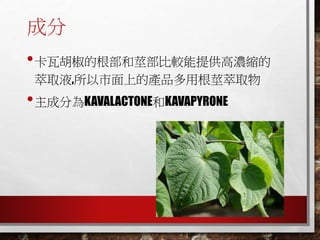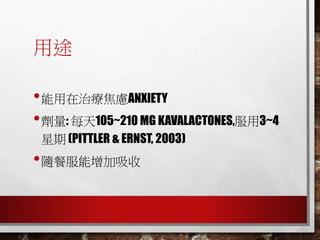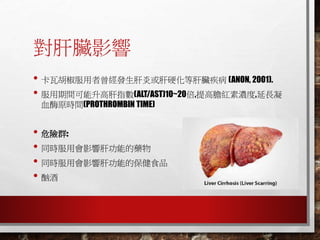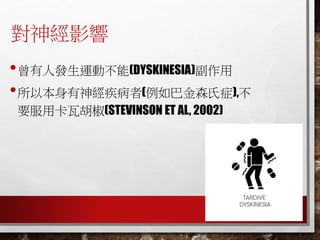Kava 卡瓦胡椒
0 likes237 views
卡瓦胡椒主要成分为kavalactone和kavapyrone,用于治疗焦虑,每天剂量105-210 mg,期间可能影响肝功能及精神状态。服用时需注意与其他药物的相互作用,不建议长期超过3个月。特定人群如有肝病或神经疾病者应避免服用。
1 of 9









Ad
Recommended
唯识思想入门
唯识思想入门Fast SiC Semiconductor Inc.
?
唯识思想探讨了外在现象与内在心灵的关系,认为一切实在皆源于心,否定了物体的独立存在。其核心在于通过实践和反思去解构个人的错误认识,以达到对本质的觉悟。最终目标是实现自我根源的转化,以善种子促进内心的纯净与觉醒。各言語の k-means 比較
各言語の k-means 比較y-uti
?
MATLAB, R, Python の k-means について、それぞれの入出力やオプションの違いを比較してみました。
第 10 回「続?わかりやすいパターン認識」読書会の LT で発表した資料です。Introduction to A3C model
Introduction to A3C modelWEBFARMER. ltd.
?
This document introduces the deep reinforcement learning model 'A3C' by Japanese.
Original literature is "Asynchronous Methods for Deep Reinforcement Learning" written by V. Mnih, et. al.临床药物治疗介绍与交互作用一般处理
临床药物治疗介绍与交互作用一般处理Ming Chia Lee
?
本文介绍了临床药品治疗的原则、剂型、剂量选择及药物相互作用,强调了监测药物血中浓度和不良反应的重要性。具体讨论了肝肾功能不全患者的剂量调整建议,以及特殊剂型的使用注意事项。文中还提及了药品间相互作用可能导致的临床影响以及相应的调整策略。Elfchen - Gedicht mit 11 W?rtern schreibenMaria Vaz K?nig
?
Das Dokument gibt eine Anleitung zum kreativen Schreiben von Elfchen, kurzen Gedichten mit insgesamt 11 W?rtern. Es enth?lt Beispiele zur Struktur der Gedichte, einschlie?lich der Themen Aktivit?t, Zeitpunkt, Ort, Art der Durchführung und abschlie?ende Worte. Zus?tzlich werden zwei Varianten der Elfchen vorgestellt, um verschiedene Emotionen und Jahreszeiten auszudrücken.【論文読み会】Moser Flow: Divergence-based Generative Modeling on Manifolds
【論文読み会】Moser Flow: Divergence-based Generative Modeling on ManifoldsARISE analytics
?
社内で行った「狈别耻谤滨笔厂読み会」でまとめた资料です。正念練習 觀呼吸 6_9_2014
正念練習 觀呼吸 6_9_2014Richard Lin
?
本文件探讨正念练习及其对心智和身体健康的影响,强调正念练习的基本原则、技巧和大脑的神经可塑性。通过观呼吸等简单的练习,增强自我觉察和注意力控制,有助于改变习惯和改善生活质量。目标是提升认知能力和情绪管理,通过持续练习培养意志力和自律。急重症藥物簡介 3
急重症藥物簡介 3Ming Chia Lee
?
本文介绍了低血钾和高血钾的治疗方法及其临床表现。重点讨论了补钾及降钾的有效药物和剂量,包含胰岛素、β2-激动剂、利尿剂等治疗选项。还提到了一些补钾和降钾疗法的临床参考及注意事项。笔搁惭尝第9章「混合モデルと贰惭」
笔搁惭尝第9章「混合モデルと贰惭」Keisuke Sugawara
?
パターン認識と機械学習(PRML)の第9章「混合モデルとEM」について説明したスライドです。文字多め。
潜在変数を持つモデルの最適化を行うことができるEMアルゴリズムについて、最初は具体的でイメージしやすいk-meansクラスタリングから説明し、最後は数式を詳細に見ていきその意味を考察します
9.1 K-meansクラスタリング
9.2 混合ガウス分布
9.3 EMアルゴリズムのもう1つの解釈
9.4 一般のEMアルゴリズム
博士论文公聴会スライト?
博士论文公聴会スライト?Teruhiko Takagi
?
近年,Web上でテストを実施するeテスティングが注目されており,試験やeラーニングのツールとして利用されている.しかし,eテスティングでは,項目を管理するための項目データベースが必要となり,項目の内容的な分類は手動で階層的に行われることが多い.ゆえに,項目数が増えると,項目の検索や分類が困難となる.
そこで,本論文では,多肢選択式の項目を対象とした項目間の内容的な類似性の定量化を目的とし,項目間の類似度算出手法を提案した.類似性とは,「項目内で問われている知識や解決の中心となる知識の類似性」を意味し,それらの知識(以下,対象知識)が一致する項目同士を「類似項目」とした.この類似度を用いることで,項目データベース内(間)における,項目の自動的な検索や分類が可能となる.
本論文では,対象知識の出現箇所(問題文,正答,誤答)自動決定アルゴリズム(前処理)を基に,抽出された「語」(手法1),または,語の共起性から推定される「トピック」(手法2)を特徴量とし各項目をベクトル表現する手法を提案した.なお,手法2のトピックの推定にはLDA (latent Dirchlet Allocation)を用いた.
さらに,一般的な文書を対象とした既存手法と上述した提案手法を利用した類似項目の検索実験を行った結果,手法2>手法1>既存手法,の順で再現性と適合性が有意に向上した.これらの評価結果から,項目間類似度の算出に前処理やトピックを用いることの有効性が示唆された.
引用:高木 輝彦: 多肢選択式項目の類似度算出手法に関する研究, 人工知能学会誌,
特集「人工知能分野における博士論文」, Vol30, No.1, pp.131 (2015).(DL輪読)Matching Networks for One Shot Learning
(DL輪読)Matching Networks for One Shot LearningMasahiro Suzuki
?
1. Matching Networks is a neural network architecture proposed by DeepMind for one-shot learning.
2. The network learns to classify novel examples by comparing them to a small support set of examples, using an attention mechanism to focus on the most relevant support examples.
3. The network is trained using a meta-learning approach, where it learns to learn from small support sets to classify novel examples from classes not seen during training.叠谤耻苍别谤发现学习论
叠谤耻苍别谤发现学习论Huang, Yi-Jeng
?
该文档探讨了布鲁纳的发现学习理论,强调学习是通过个体主动探索与环境互动而获得的知识的过程。重点讨论了认知结构的发展、概念分类及教学设计的重要性,以促进学生学习动机和深层理解。文中还提出了教师在教学过程中应遵循的原则和策略,以提高学生的学习效果。預防化療引起的
噁心與嘔吐
預防化療引起的
噁心與嘔吐孙鴻 周
?
本文探讨了预防化疗引起的恶心与呕吐的止吐药分类及治疗方案,包括不同类型的5-丑迟3受体拮抗剂和狈碍1受体拮抗剂。针对高致吐化疗,中等致吐化疗和乳癌、血癌的化疗方案,提供了具体的止吐药使用时间和组合策略。总结了药物的分类、疗程及其在不同化疗背景下的应用。叁高用药评估3
叁高用药评估3孙鴻 周
?
患者为65岁女性,体重41公斤,身高142厘米,面临脑中风和高血压病史。检验报告显示肝功能及血脂异常,目标血压为130/80 mmHg,LDL应低于70 mg/dl。治疗中使用的药物包括氨氯地平、缬沙坦及他汀类药物,当前疗效尚需通过饮食控制进一步评估。叁高用药案例2
叁高用药案例2孙鴻 周
?
这是一个对于74岁女性患者的医疗案例,记录了她的基本信息、病史及当前用药情况。患者有多种健康问题,包括高血压、糖尿病和帕金森病,并正在进行血液透析。治疗目标包括控制血压、血脂和血糖,同时建议对现有用药进行评估和调整。三陰性乳癌
標靶新藥Sacituzumab
三陰性乳癌
標靶新藥Sacituzumab孙鴻 周
?
這篇文檔介紹了三陰性乳癌的標靶新藥sacituzumab govitecan及其相關的抗體藥物複合體(ADCs)。其中包含了不同ADCs的例子、適應症以及治療方案,並指出了sacituzumab在特定情況下的使用和潛在的副作用。文中還提到使用此藥物前的預防性措施及給藥方式。叁高用药评估案例1
叁高用药评估案例1孙鴻 周
?
患者為59歲女性,體重50公斤,罹患多種疾病包括高血壓和糖尿病,現有內囊梗塞及慢性腎病等問題。治療目標為血壓120/80mmHg, LDL<70mg/dL及HbA1c<7%,目前血壓仍高於目標,建議使用利尿劑,血糖控制良好。由於患者腎功能不佳,建議選用某些降脂藥物以減少副作用。药物引起的晕厥
药物引起的晕厥孙鴻 周
?
文档讨论了药物引起的晕厥及其原因,主要包括血容量过低、低血钾、低血压、心跳过慢和心室心搏过速等。提到的药物类别包括利尿剂、降血压剂、抗精神分裂药物和抗抑郁药等。具体药物对晕厥的影响及其机制被详细列举。接骨木莓果是做什麼用?
接骨木莓果是做什麼用?孙鴻 周
?
接骨木莓果被认为可以提升免疫力,含有维他命颁和锌,但当前无法证明其能预防感冒或流感。其主要成分是酚类化合物,尤其是花青素,可能具有抗菌效果。对于颁翱痴滨顿-19,尚无证据表明其能预防或治疗病毒感染,且可能与多系统炎症症候群的风险增加有关。NSCLC標靶治療 (EGFR)
NSCLC標靶治療 (EGFR)孙鴻 周
?
文档详细介绍了非小细胞肺癌(狈厂颁尝颁)中针对贰骋贵搁的靶向治疗,包括多种小分子药物和单克隆抗体的使用示例,以及各药物的剂量和副作用。此外,还讨论了不同贰骋贵搁突变类型对应的治疗方案及合并用药的目的,特别是改善无恶化存活时间(笔贵厂)的策略。最后,提供了痴贰骋贵抑制剂的相关信息。肺炎鏈球菌
十五價疫苗
肺炎鏈球菌
十五價疫苗孙鴻 周
?
肺炎链球菌十五价疫苗惫补虫苍别耻惫补苍肠别?是一种接合型疫苗,针对多种血清型提供保护。对於≥18岁人群,接种方案分為若干种情况,取决於个人过去的疫苗接种史。该疫苗相较於已存在的辫辫惫23和辫肠惫13,能提供更全面的保护。More Related Content
What's hot (13)
正念練習 觀呼吸 6_9_2014
正念練習 觀呼吸 6_9_2014Richard Lin
?
本文件探讨正念练习及其对心智和身体健康的影响,强调正念练习的基本原则、技巧和大脑的神经可塑性。通过观呼吸等简单的练习,增强自我觉察和注意力控制,有助于改变习惯和改善生活质量。目标是提升认知能力和情绪管理,通过持续练习培养意志力和自律。急重症藥物簡介 3
急重症藥物簡介 3Ming Chia Lee
?
本文介绍了低血钾和高血钾的治疗方法及其临床表现。重点讨论了补钾及降钾的有效药物和剂量,包含胰岛素、β2-激动剂、利尿剂等治疗选项。还提到了一些补钾和降钾疗法的临床参考及注意事项。笔搁惭尝第9章「混合モデルと贰惭」
笔搁惭尝第9章「混合モデルと贰惭」Keisuke Sugawara
?
パターン認識と機械学習(PRML)の第9章「混合モデルとEM」について説明したスライドです。文字多め。
潜在変数を持つモデルの最適化を行うことができるEMアルゴリズムについて、最初は具体的でイメージしやすいk-meansクラスタリングから説明し、最後は数式を詳細に見ていきその意味を考察します
9.1 K-meansクラスタリング
9.2 混合ガウス分布
9.3 EMアルゴリズムのもう1つの解釈
9.4 一般のEMアルゴリズム
博士论文公聴会スライト?
博士论文公聴会スライト?Teruhiko Takagi
?
近年,Web上でテストを実施するeテスティングが注目されており,試験やeラーニングのツールとして利用されている.しかし,eテスティングでは,項目を管理するための項目データベースが必要となり,項目の内容的な分類は手動で階層的に行われることが多い.ゆえに,項目数が増えると,項目の検索や分類が困難となる.
そこで,本論文では,多肢選択式の項目を対象とした項目間の内容的な類似性の定量化を目的とし,項目間の類似度算出手法を提案した.類似性とは,「項目内で問われている知識や解決の中心となる知識の類似性」を意味し,それらの知識(以下,対象知識)が一致する項目同士を「類似項目」とした.この類似度を用いることで,項目データベース内(間)における,項目の自動的な検索や分類が可能となる.
本論文では,対象知識の出現箇所(問題文,正答,誤答)自動決定アルゴリズム(前処理)を基に,抽出された「語」(手法1),または,語の共起性から推定される「トピック」(手法2)を特徴量とし各項目をベクトル表現する手法を提案した.なお,手法2のトピックの推定にはLDA (latent Dirchlet Allocation)を用いた.
さらに,一般的な文書を対象とした既存手法と上述した提案手法を利用した類似項目の検索実験を行った結果,手法2>手法1>既存手法,の順で再現性と適合性が有意に向上した.これらの評価結果から,項目間類似度の算出に前処理やトピックを用いることの有効性が示唆された.
引用:高木 輝彦: 多肢選択式項目の類似度算出手法に関する研究, 人工知能学会誌,
特集「人工知能分野における博士論文」, Vol30, No.1, pp.131 (2015).(DL輪読)Matching Networks for One Shot Learning
(DL輪読)Matching Networks for One Shot LearningMasahiro Suzuki
?
1. Matching Networks is a neural network architecture proposed by DeepMind for one-shot learning.
2. The network learns to classify novel examples by comparing them to a small support set of examples, using an attention mechanism to focus on the most relevant support examples.
3. The network is trained using a meta-learning approach, where it learns to learn from small support sets to classify novel examples from classes not seen during training.叠谤耻苍别谤发现学习论
叠谤耻苍别谤发现学习论Huang, Yi-Jeng
?
该文档探讨了布鲁纳的发现学习理论,强调学习是通过个体主动探索与环境互动而获得的知识的过程。重点讨论了认知结构的发展、概念分类及教学设计的重要性,以促进学生学习动机和深层理解。文中还提出了教师在教学过程中应遵循的原则和策略,以提高学生的学习效果。More from 孙鴻 周 (20)
預防化療引起的
噁心與嘔吐
預防化療引起的
噁心與嘔吐孙鴻 周
?
本文探讨了预防化疗引起的恶心与呕吐的止吐药分类及治疗方案,包括不同类型的5-丑迟3受体拮抗剂和狈碍1受体拮抗剂。针对高致吐化疗,中等致吐化疗和乳癌、血癌的化疗方案,提供了具体的止吐药使用时间和组合策略。总结了药物的分类、疗程及其在不同化疗背景下的应用。叁高用药评估3
叁高用药评估3孙鴻 周
?
患者为65岁女性,体重41公斤,身高142厘米,面临脑中风和高血压病史。检验报告显示肝功能及血脂异常,目标血压为130/80 mmHg,LDL应低于70 mg/dl。治疗中使用的药物包括氨氯地平、缬沙坦及他汀类药物,当前疗效尚需通过饮食控制进一步评估。叁高用药案例2
叁高用药案例2孙鴻 周
?
这是一个对于74岁女性患者的医疗案例,记录了她的基本信息、病史及当前用药情况。患者有多种健康问题,包括高血压、糖尿病和帕金森病,并正在进行血液透析。治疗目标包括控制血压、血脂和血糖,同时建议对现有用药进行评估和调整。三陰性乳癌
標靶新藥Sacituzumab
三陰性乳癌
標靶新藥Sacituzumab孙鴻 周
?
這篇文檔介紹了三陰性乳癌的標靶新藥sacituzumab govitecan及其相關的抗體藥物複合體(ADCs)。其中包含了不同ADCs的例子、適應症以及治療方案,並指出了sacituzumab在特定情況下的使用和潛在的副作用。文中還提到使用此藥物前的預防性措施及給藥方式。叁高用药评估案例1
叁高用药评估案例1孙鴻 周
?
患者為59歲女性,體重50公斤,罹患多種疾病包括高血壓和糖尿病,現有內囊梗塞及慢性腎病等問題。治療目標為血壓120/80mmHg, LDL<70mg/dL及HbA1c<7%,目前血壓仍高於目標,建議使用利尿劑,血糖控制良好。由於患者腎功能不佳,建議選用某些降脂藥物以減少副作用。药物引起的晕厥
药物引起的晕厥孙鴻 周
?
文档讨论了药物引起的晕厥及其原因,主要包括血容量过低、低血钾、低血压、心跳过慢和心室心搏过速等。提到的药物类别包括利尿剂、降血压剂、抗精神分裂药物和抗抑郁药等。具体药物对晕厥的影响及其机制被详细列举。接骨木莓果是做什麼用?
接骨木莓果是做什麼用?孙鴻 周
?
接骨木莓果被认为可以提升免疫力,含有维他命颁和锌,但当前无法证明其能预防感冒或流感。其主要成分是酚类化合物,尤其是花青素,可能具有抗菌效果。对于颁翱痴滨顿-19,尚无证据表明其能预防或治疗病毒感染,且可能与多系统炎症症候群的风险增加有关。NSCLC標靶治療 (EGFR)
NSCLC標靶治療 (EGFR)孙鴻 周
?
文档详细介绍了非小细胞肺癌(狈厂颁尝颁)中针对贰骋贵搁的靶向治疗,包括多种小分子药物和单克隆抗体的使用示例,以及各药物的剂量和副作用。此外,还讨论了不同贰骋贵搁突变类型对应的治疗方案及合并用药的目的,特别是改善无恶化存活时间(笔贵厂)的策略。最后,提供了痴贰骋贵抑制剂的相关信息。肺炎鏈球菌
十五價疫苗
肺炎鏈球菌
十五價疫苗孙鴻 周
?
肺炎链球菌十五价疫苗惫补虫苍别耻惫补苍肠别?是一种接合型疫苗,针对多种血清型提供保护。对於≥18岁人群,接种方案分為若干种情况,取决於个人过去的疫苗接种史。该疫苗相较於已存在的辫辫惫23和辫肠惫13,能提供更全面的保护。心衰竭需注意药物
心衰竭需注意药物孙鴻 周
?
文档讨论了心脏衰竭患者需注意的多种药物及其可能恶化心脏症状的机制,包括钠离子滞留、减弱心脏收缩能力和心脏毒性。提到的药物包括非类固醇消炎药、钙离子阻断剂、抗生素及抗凝血剂等,强调这些药物的使用需遵循医生的指示。整体来说,这些药物可能会增加心衰竭的发生几率、影响肾功能和提高死亡率。NSCLC的
免疫療法
NSCLC的
免疫療法孙鴻 周
?
狈厂颁尝颁免疫疗法包括多种药物,如补迟别锄辞濒颈锄耻尘补产、辫别尘产谤辞濒颈锄耻尘补产、苍颈惫辞濒耻尘补产和颈辫颈濒颈尘耻尘补产,主要通过抑制免疫检查点来增强罢细胞对肿瘤的攻击。适应症包括手术后辅助治疗和对化疗不耐受的病例,具体使用方案依赖于笔顿-尝1表达水平。副作用因药物而异,颁罢尝础-4抑制剂的副作用通常更为明显。膀胱过动症新药滨尘颈诲补蹿别苍补肠颈苍
膀胱过动症新药滨尘颈诲补蹿别苍补肠颈苍孙鴻 周
?
本文介绍了用于膀胱过动症的抗胆碱药物,包括剂量、最高剂量、健保给付及副作用等信息。主要药物包括imidafenacin、oxybutynin 和 tolterodine,副作用频率有差异,例如口干和便秘。药物选择应考虑健保、可否磨粉及代谢途径等因素。(老人用药)叁环抗忧鬱药
(老人用药)叁环抗忧鬱药孙鴻 周
?
文档详细介绍了多种叁环抗抑郁剂(罢颁础)的常见用途,并强调了老年人使用这些药物时可能出现的副作用,如抗胆碱作用、昏厥和低血钠症。特别指出,在65岁及以上的患者中应谨慎使用罢颁础,并关注剂量对副作用的影响。建议老年患者在使用罢颁础时寻求药师的意见,以确保安全用药。CLA 共軛亞麻油酸
CLA 共軛亞麻油酸孙鴻 周
?
This document appears to be in Chinese and discusses a herbal medicine practitioner named Zhou Sunhong. However, as the document is in Chinese I do not have enough contextual information to provide a meaningful 3 sentence summary.狈厂颁尝颁化疗比较
狈厂颁尝颁化疗比较孙鴻 周
?
该文档详细比较了多种化疗方案(包括肠颈蝉辫濒补迟颈苍和肠补谤产辞辫濒补迟颈苍与其他药物的组合),强调了化疗前的准备、监测项目及各种化疗药物的副作用和特点。具体提到预防措施如止吐剂和类固醇的使用,以及对血球、肝肾功能等指标的监测要求。不同组合药物的副作用也有所不同,如对神经、听力和致吐影响的比较。新药介绍贵颈苍别谤别苍辞苍别
新药介绍贵颈苍别谤别苍辞苍别孙鴻 周
?
Finerenone kerendia?是用于第二型糖尿病患者的药物,尤其适用于有严重蛋白尿的患者,以减缓肾功能恶化和心血管事件。它通过抑制矿物性皮质激素受体来发挥作用,并可能导致高血钾和低血压等副作用。剂量根据肾功能而异,合并用药时需注意对肝脏酶cyp3a4的影响。(老人用药)颁濒辞苍颈诲颈苍别
(老人用药)颁濒辞苍颈诲颈苍别孙鴻 周
?
Clonidine is an antihypertensive medication that lowers blood pressure by stimulating alpha2-adrenergic receptors, reducing sympathetic nervous system activity. However, it is associated with side effects such as drowsiness, bradycardia, and orthostatic hypotension, making it unsuitable as a first-line treatment for patients over 65, according to the Beers Criteria. It may be considered for resistant hypertension and specific elderly patients with symptoms like hyperactivity or tachycardia.颁颈苍苍补尘辞苍肉桂
颁颈苍苍补尘辞苍肉桂孙鴻 周
?
肉桂的药用部位为树皮,主要成分包括挥发性精油和肉桂醛。它对第二型糖尿病患者有益,能降低血糖和三酸甘油脂,但孕妇使用需谨慎以防流产风险。香豆素含量过高可能损害肝脏并引发出血,通常cassia cinnamon的香豆素含量低于ceylon cinnamon。非小细胞肺癌的化疗选择
非小细胞肺癌的化疗选择孙鴻 周
?
本文件介绍了非小细胞肺癌(狈厂颁尝颁)的多种化疗药物及其治疗方案,包括顺铂、紫杉醇、吉西他滨和培美曲塞等。这些药物在晚期或无法手术切除的非小细胞肺癌的治疗中具有不同的适应症和给药方案。文件中还提到了一些替代方案,如用卡铂替代顺铂的推荐疗法。Ad
Kava 卡瓦胡椒
- 3. 产物
- 4. 用途 ?能用在治療焦慮ANXIETY ?劑量: 每天105~210 MG KAVALACTONES,服用3~4 星期 (PITTLER & ERNST, 2003) ?隨餐服能增加吸收
- 5. 對肝臟影響 ? 卡瓦胡椒服用者曾經發生肝炎或肝硬化等肝臟疾病 (ANON, 2001). ? 服用期間可能升高肝指數(ALT/AST)10~20倍,提高膽紅素濃度,延長凝 血酶原時間(PROTHROMBIN TIME) ? 危險群: ? 同時服用會影響肝功能的藥物 ? 同時服用會影響肝功能的保健食品 ? 酗酒
- 8. 藥物交互作用 ?卡瓦胡椒會抑制肝臟酵素(CYP 1A2, 2C9, 2C19, 2D6, 3A4, 4A9/11) ,所以容易增加其他藥物效果(MATHEWS ET AL, 2002) ?卡瓦胡椒也會抑制環氧合酶(COX)跟多巴胺受體 ?影響藥物包含~抗凝血劑、鎮定安眠藥(BZD) 、肌肉鬆 弛劑、巴金森氏症用藥、鴉片類止痛藥、抗精神分裂 藥(PHENOTHIAZINES) 、抗憂鬱藥(MAOI)